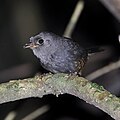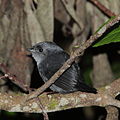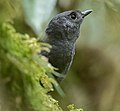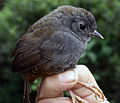| Image | Common name | Scientific name | Distribution |
|---|
| Marsh tapaculo or wetland tapaculo | Scytalopus iraiensis | Brazil. |
 | Diamantina tapaculo | Scytalopus diamantinensis | Brazil (Bahia) |
 | Brasília tapaculo | Scytalopus novacapitalis | Brazil (Goiás, the Distrito Federal, and western Minas Gerais.) |
 | Rock tapaculo | Scytalopus petrophilus | Brazil (Rio de Janeiro and São Paulo) |
 | Planalto tapaculo | Scytalopus pachecoi | southeastern Brazil and extreme northeastern Argentina. |
 | Blackish tapaculo | Scytalopus latrans | Colombia, Ecuador, Peru, and Venezuela. |
 | Mouse-coloured tapaculo | Scytalopus speluncae | Brazil (Espírito Santo to northeastern Rio Grande do Sul.) |
 | Dusky tapaculo | Scytalopus fuscus | Chile. |
 | Magellanic tapaculo | Scytalopus magellanicus | Chile (Tierra del Fuego as far as Valparaíso Region), Argentina ( San Juan Province) |
 | Ancash tapaculo | Scytalopus affinis | Peru. |
| White-winged tapaculo | Scytalopus krabbei | Peru |
 | Loja tapaculo | Scytalopus androstictus | Ecuador (Zamora-Chinchipe Province), Peru( Department of Cajamarca) |
 | Paramo tapaculo | Scytalopus opacus | southern Colombia to south-central Ecuador |
| Paramillo tapaculo | Scytalopus canus | Colombia. |
 | White-browed tapaculo | Scytalopus superciliaris | northwestern Argentina |
 | Zimmer's tapaculo | Scytalopus zimmeri | Bolivia and Argentina |
 | Puna tapaculo | Scytalopus simonsi | Bolivia and Peru |
 | Diademed tapaculo | Scytalopus schulenbergi | Bolivia and Peru. |
 | Vilcabamba tapaculo | Scytalopus urubambae | Peru |
| Ampay tapaculo | Scytalopus whitneyi | Peru. |
 | Jalca tapaculo | Scytalopus frankeae | Peru. |
 | Neblina tapaculo | Scytalopus altirostris | northern Peru |
 | Trilling tapaculo | Scytalopus parvirostris | Bolivia and Peru. |
| Bolivian tapaculo | Scytalopus bolivianus | Bolivia and Peru. |
| White-crowned tapaculo | Scytalopus atratus | Bolivia, Colombia, Ecuador, Peru, and Venezuela. |
| Santa Marta tapaculo | Scytalopus sanctaemartae | Colombia (Sierra Nevada de Santa Marta) |
 | Long-tailed tapaculo | Scytalopus micropterus | Colombia, Ecuador and far northern Peru |
| Rufous-vented tapaculo | Scytalopus femoralis | Peru |
| Utcubamba tapaculo | Scytalopus intermedius | Peru. |
| Large-footed tapaculo | Scytalopus macropus | Peru. |
 | Junin tapaculo | Scytalopus gettyae | Peru. |
| Unicolored tapaculo | Scytalopus unicolor | Peru. |
 | Tschudi's tapaculo | Scytalopus acutirostris | Peru. |
| Boa Nova tapaculo | Scytalopus gonzagai | Brazil(Bahia) |
 | Silvery-fronted tapaculo | Scytalopus argentifrons | Costa Rica and Panama. |
 | Nariño tapaculo | Scytalopus vicinior | Colombia and Ecuador. |
| Tacarcuna tapaculo or pale-throated tapaculo | Scytalopus panamensis | Panama and Colombia |
 | Chocó tapaculo | Scytalopus chocoensis | Colombia, Ecuador, and Panama. |
| Magdalena tapaculo | Scytalopus rodriguezi | Colombia |
| Stiles's tapaculo | Scytalopus stilesi | Colombia |
 | Tatama tapaculo | Scytalopus alvarezlopezi | Colombia |
| El Oro tapaculo or Ecuadorian tapaculo | Scytalopus robbinsi | south-western Ecuador |
| Caracas tapaculo | Scytalopus caracae | Venezuela. |
 | Pale-bellied tapaculo | Scytalopus griseicollis | Colombia and Venezuela |
 | Brown-rumped tapaculo | Scytalopus latebricola | Colombia |
 | Perijá tapaculo | Scytalopus perijanus | Colombia, Venezuela |
| Mérida tapaculo | Scytalopus meridanus | Venezuela. |
 | Chusquea tapaculo | Scytalopus parkeri | southern Ecuador and far northern Peru. |
| Spillmann's tapaculo | Scytalopus spillmanni | Colombia and Ecuador. |
|































